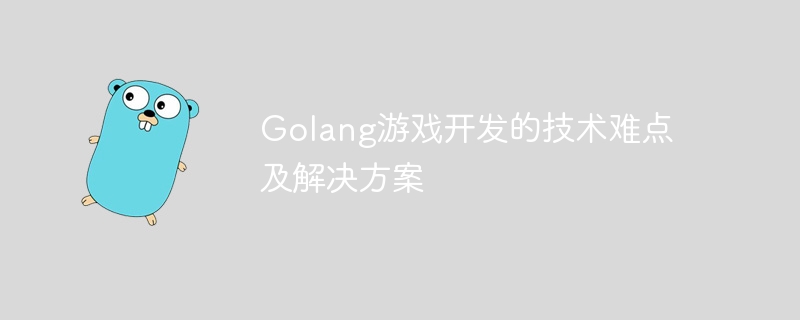Home >Backend Development >Golang >Technical difficulties and solutions in Golang game development
Technical difficulties and solutions in Golang game development
- 王林Original
- 2024-03-06 22:27:03458browse

Technical difficulties and solutions in Golang game development
With the continuous development of the game industry, more and more developers are beginning to try to use Golang to develop games. As an efficient and highly concurrency programming language, Golang provides many advantages for game development. However, in the process of using Golang to develop games, you will also encounter some technical difficulties. This article will introduce common technical difficulties in Golang game development, provide corresponding solutions, and attach specific code examples.
1. Concurrent Programming
In game development, a large number of concurrent operations are usually involved, such as processing player input, updating game world state, rendering pictures, etc. Concurrent programming can be easily performed using Golang's goroutine and channel mechanisms, but care needs to be taken to avoid issues such as race conditions and deadlocks.
Solution:
- Use a mutex to protect shared resources and avoid data competition caused by simultaneous access by multiple goroutines.
- Use channels for communication between goroutines to avoid sharing data directly.
- Use other synchronization primitives provided by the sync package, such as WaitGroup, Once, etc., to manage the execution order of goroutine.
Sample code:
package main
import (
"fmt"
"sync"
)
var (
counter int
mutex sync.Mutex
)
func increment() {
mutex.Lock()
defer mutex.Unlock()
counter++
}
func main() {
var wg sync.WaitGroup
for i := 0; i < 10; i++ {
wg.Add(1)
go func() {
defer wg.Done()
increment()
}()
}
wg.Wait()
fmt.Println("Counter:", counter)
}2. Performance optimization
Game development has high performance requirements, so when using Golang to develop games, you need to pay attention to the performance optimization of the code , including reducing memory allocation, reducing CPU usage, etc.
Solution:
- Try to reduce unnecessary memory allocation, such as reusing objects as much as possible, using pointers, etc.
- Use performance analysis tools (such as pprof) to find performance bottlenecks and optimize them.
- Use caching reasonably to reduce the amount of calculation, such as caching calculation results, caching rendering results, etc.
Sample code:
package main
import (
"fmt"
"time"
)
func fibonacci(n int) int {
if n <= 1 {
return n
}
return fibonacci(n-1) + fibonacci(n-2)
}
func main() {
start := time.Now()
result := fibonacci(40)
elapsed := time.Since(start)
fmt.Printf("Result: %d
", result)
fmt.Printf("Elapsed time: %s
", elapsed)
}3. Cross-platform development
Game development needs to support multiple platforms, so you need to consider how to deploy and debug on different platforms . Using Golang to develop games can easily achieve cross-platform support, but you need to pay attention to handling platform-related differences.
Solution:
- Use build tags to distinguish code under different platforms and implement platform-related logic.
- Specify different target platforms during compilation to generate corresponding executable files.
- Use third-party libraries to handle platform-related operations, such as window management, graphics rendering, etc.
Sample code:
// +build windows
package main
import (
"log"
"github.com/lxn/walk"
)
func main() {
walk.App().Run()
}Summary:
When using Golang to develop games, you need to pay attention to technical difficulties such as concurrent programming, performance optimization, and cross-platform development. With reasonable solutions and code examples, high-quality game products can be developed more efficiently. I hope this article will be helpful to Golang game developers.
The above is the detailed content of Technical difficulties and solutions in Golang game development. For more information, please follow other related articles on the PHP Chinese website!
Related articles
See more- Detailed explanation of the implementation of bounded cache in JAVA concurrent programming
- java concurrent programming (4) performance and scalability
- Let's take a look at the new features and performance optimizations of php7 and PHP5.
- Golang development: Build stable code using test-driven development
- Understanding the roles and responsibilities of Golang development engineers

